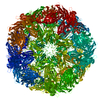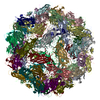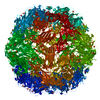+ Open data
Open data
- Basic information
Basic information
| Entry | Database: EMDB / ID: EMD-8969 | |||||||||
|---|---|---|---|---|---|---|---|---|---|---|
| Title | Mechanism of cellular recognition by PCV2 | |||||||||
 Map data Map data | Symmetrized image reconstruction of PCV2 in complex with heparin sulfate | |||||||||
 Sample Sample |
| |||||||||
 Keywords Keywords | viral jelly-roll / VIRUS LIKE PARTICLE | |||||||||
| Function / homology | Circovirus capsid protein / Circovirus capsid superfamily / Circovirus capsid protein / viral capsid assembly / T=1 icosahedral viral capsid / symbiont entry into host cell / virion attachment to host cell / Cap Function and homology information Function and homology information | |||||||||
| Biological species |   Porcine circovirus 2 Porcine circovirus 2 | |||||||||
| Method | single particle reconstruction / cryo EM / Resolution: 2.8 Å | |||||||||
 Authors Authors | Khayat R / Dhindwal S | |||||||||
| Funding support |  United States, 1 items United States, 1 items
| |||||||||
 Citation Citation |  Journal: J Virol / Year: 2019 Journal: J Virol / Year: 2019Title: Porcine Circovirus 2 Uses a Multitude of Weak Binding Sites To Interact with Heparan Sulfate, and the Interactions Do Not Follow the Symmetry of the Capsid. Authors: Sonali Dhindwal / Bryant Avila / Shanshan Feng / Reza Khayat /  Abstract: Porcine circovirus 2 (PCV2) is the smallest pathogenic virus capable of autonomous replication within its host. Infections result in immunosuppression and subsequent death of the host and are ...Porcine circovirus 2 (PCV2) is the smallest pathogenic virus capable of autonomous replication within its host. Infections result in immunosuppression and subsequent death of the host and are initiated via the attachment of the PCV2 icosahedral capsid to heparan sulfate (HS) and chondroitin sulfate B (CSB) glycosaminoglycans on the cell surface. However, the underlying mechanism of structural recognition remains to be explored. Using heparin, a routinely used analog of heparan sulfate, we demonstrate that increasing lengths of heparin exhibit a greater affinity toward PCV2. Our competition assays indicate that dextran sulfate (8 kDa) has a higher affinity for PCV2 than heparin (12 kDa), chondroitin sulfate B (41 kDa), hyaluronic acid (1.6 MDa), and dextran (6 kDa). This suggests that polymers high in sulfate content are capable of competing with the PCV2-heparan sulfate interaction and, thus, have the potential to inhibit PCV2 infection. Finally, we visualized the interaction between heparin and the PCV2 capsid using cryo-electron microscopy single-particle analysis, symmetry expansion, and focused classification. The image reconstructions provide the first example of an asymmetric distribution of heparin on the surface of an icosahedral virus capsid. We demonstrate that each of the 60 capsid subunits that generate the T1 capsid can bind heparin via one of five binding sites. However, not all of the binding sites were occupied by heparin, and only one-third to two-thirds of the binding sites were occupied. The binding sites are defined by arginine, lysine, and polar amino acids. Mutating the arginine, lysine, and polar amino acids to alanine diminished the binding capacity of PCV2 to heparin. It has been demonstrated that porcine circovirus 2 (PCV2) attaches to cells via heparan sulfate (HS) and chondroitin sulfate B (CSB) glycosaminoglycans; however, the underlying structural mechanism describing the HS/CSB recognition by PCV2 remains to be explored. We used cryo-electron microscopy with single-particle analysis, symmetry expansion, and focused classification to visualize the interaction between the PCV2 capsid and heparin, an analog of heparan sulfate, to better than 3.6-Å resolution. We observed that the interaction between PCV2 and heparin does not adhere to the icosahedral symmetry of the capsid. To the best of our knowledge, this is the first example where the interaction between heparin and an icosahedral capsid does not follow the symmetry elements of the capsid. Our findings also suggest that anionic polymers, such as dextran sulfate, may act to inhibit PCV2 infection. | |||||||||
| History |
|
- Structure visualization
Structure visualization
| Movie |
 Movie viewer Movie viewer |
|---|---|
| Structure viewer | EM map:  SurfView SurfView Molmil Molmil Jmol/JSmol Jmol/JSmol |
| Supplemental images |
- Downloads & links
Downloads & links
-EMDB archive
| Map data |  emd_8969.map.gz emd_8969.map.gz | 94.7 MB |  EMDB map data format EMDB map data format | |
|---|---|---|---|---|
| Header (meta data) |  emd-8969-v30.xml emd-8969-v30.xml emd-8969.xml emd-8969.xml | 15.8 KB 15.8 KB | Display Display |  EMDB header EMDB header |
| Images |  emd_8969.png emd_8969.png | 119.6 KB | ||
| Filedesc metadata |  emd-8969.cif.gz emd-8969.cif.gz | 6 KB | ||
| Archive directory |  http://ftp.pdbj.org/pub/emdb/structures/EMD-8969 http://ftp.pdbj.org/pub/emdb/structures/EMD-8969 ftp://ftp.pdbj.org/pub/emdb/structures/EMD-8969 ftp://ftp.pdbj.org/pub/emdb/structures/EMD-8969 | HTTPS FTP |
-Validation report
| Summary document |  emd_8969_validation.pdf.gz emd_8969_validation.pdf.gz | 632.3 KB | Display |  EMDB validaton report EMDB validaton report |
|---|---|---|---|---|
| Full document |  emd_8969_full_validation.pdf.gz emd_8969_full_validation.pdf.gz | 631.9 KB | Display | |
| Data in XML |  emd_8969_validation.xml.gz emd_8969_validation.xml.gz | 6.5 KB | Display | |
| Data in CIF |  emd_8969_validation.cif.gz emd_8969_validation.cif.gz | 7.4 KB | Display | |
| Arichive directory |  https://ftp.pdbj.org/pub/emdb/validation_reports/EMD-8969 https://ftp.pdbj.org/pub/emdb/validation_reports/EMD-8969 ftp://ftp.pdbj.org/pub/emdb/validation_reports/EMD-8969 ftp://ftp.pdbj.org/pub/emdb/validation_reports/EMD-8969 | HTTPS FTP |
-Related structure data
| Related structure data |  6e2rMC  8939C  8970C  8971C  8972C  8973C  8974C  8975C  6dzuC  6e2xC  6e2zC  6e30C  6e32C  6e34C  6e39C C: citing same article ( M: atomic model generated by this map |
|---|---|
| Similar structure data |
- Links
Links
| EMDB pages |  EMDB (EBI/PDBe) / EMDB (EBI/PDBe) /  EMDataResource EMDataResource |
|---|---|
| Related items in Molecule of the Month |
- Map
Map
| File |  Download / File: emd_8969.map.gz / Format: CCP4 / Size: 103 MB / Type: IMAGE STORED AS FLOATING POINT NUMBER (4 BYTES) Download / File: emd_8969.map.gz / Format: CCP4 / Size: 103 MB / Type: IMAGE STORED AS FLOATING POINT NUMBER (4 BYTES) | ||||||||||||||||||||||||||||||||||||||||||||||||||||||||||||
|---|---|---|---|---|---|---|---|---|---|---|---|---|---|---|---|---|---|---|---|---|---|---|---|---|---|---|---|---|---|---|---|---|---|---|---|---|---|---|---|---|---|---|---|---|---|---|---|---|---|---|---|---|---|---|---|---|---|---|---|---|---|
| Annotation | Symmetrized image reconstruction of PCV2 in complex with heparin sulfate | ||||||||||||||||||||||||||||||||||||||||||||||||||||||||||||
| Voxel size | X=Y=Z: 1.09 Å | ||||||||||||||||||||||||||||||||||||||||||||||||||||||||||||
| Density |
| ||||||||||||||||||||||||||||||||||||||||||||||||||||||||||||
| Symmetry | Space group: 1 | ||||||||||||||||||||||||||||||||||||||||||||||||||||||||||||
| Details | EMDB XML:
CCP4 map header:
| ||||||||||||||||||||||||||||||||||||||||||||||||||||||||||||
-Supplemental data
- Sample components
Sample components
-Entire : Porcine circovirus 2
| Entire | Name:   Porcine circovirus 2 Porcine circovirus 2 |
|---|---|
| Components |
|
-Supramolecule #1: Porcine circovirus 2
| Supramolecule | Name: Porcine circovirus 2 / type: virus / ID: 1 / Parent: 0 / Macromolecule list: all / NCBI-ID: 85708 / Sci species name: Porcine circovirus 2 / Virus type: VIRUS-LIKE PARTICLE / Virus isolate: SPECIES / Virus enveloped: No / Virus empty: No |
|---|---|
| Host (natural) | Organism:  |
| Virus shell | Shell ID: 1 / Name: Capsid protein / Diameter: 215.0 Å / T number (triangulation number): 1 |
-Macromolecule #1: Capsid protein of PCV2
| Macromolecule | Name: Capsid protein of PCV2 / type: protein_or_peptide / ID: 1 / Number of copies: 60 / Enantiomer: LEVO |
|---|---|
| Source (natural) | Organism:   Porcine circovirus 2 Porcine circovirus 2 |
| Molecular weight | Theoretical: 27.899795 KDa |
| Recombinant expression | Organism:  Trichoplusia ni (cabbage looper) Trichoplusia ni (cabbage looper) |
| Sequence | String: MTYPRRRYRR RRHRPRSHLG QILRRRPWLV HPRHRYRWRR KNGIFNTRLS RTFGYTIKRT TVKTPSWAVD MMRFNINDFL PPGGGSNPR SVPFEYYRIR KVKVEFWPCS PITQGDRGVG SSAVILDDNF VTKATALTYD PYVNYSSRHT ITQPFSYHSR Y FTPKPVLD ...String: MTYPRRRYRR RRHRPRSHLG QILRRRPWLV HPRHRYRWRR KNGIFNTRLS RTFGYTIKRT TVKTPSWAVD MMRFNINDFL PPGGGSNPR SVPFEYYRIR KVKVEFWPCS PITQGDRGVG SSAVILDDNF VTKATALTYD PYVNYSSRHT ITQPFSYHSR Y FTPKPVLD STIDYFQPNN KRNQLWLRLQ TAGNVDHVGL GTAFENSIYD QEYNIRVTMY VQFREFNLKD PPLNP UniProtKB: Cap |
-Experimental details
-Structure determination
| Method | cryo EM |
|---|---|
 Processing Processing | single particle reconstruction |
| Aggregation state | particle |
- Sample preparation
Sample preparation
| Concentration | 0.718 mg/mL | |||||||||||||||
|---|---|---|---|---|---|---|---|---|---|---|---|---|---|---|---|---|
| Buffer | pH: 7 Component:
| |||||||||||||||
| Grid | Support film - Material: CARBON / Support film - topology: LACEY / Details: unspecified | |||||||||||||||
| Vitrification | Cryogen name: ETHANE / Chamber humidity: 100 % / Chamber temperature: 4 K / Instrument: FEI VITROBOT MARK IV | |||||||||||||||
| Details | This sample was monodisperse |
- Electron microscopy
Electron microscopy
| Microscope | FEI TITAN |
|---|---|
| Image recording | Film or detector model: GATAN K2 SUMMIT (4k x 4k) / Detector mode: COUNTING / Digitization - Frames/image: 2-50 / Number grids imaged: 1 / Number real images: 1149 / Average exposure time: 5.0 sec. / Average electron dose: 35.0 e/Å2 |
| Electron beam | Acceleration voltage: 300 kV / Electron source:  FIELD EMISSION GUN FIELD EMISSION GUN |
| Electron optics | C2 aperture diameter: 100.0 µm / Calibrated defocus max: 3.2 µm / Calibrated defocus min: 0.28 µm / Illumination mode: FLOOD BEAM / Imaging mode: BRIGHT FIELD / Cs: 2.7 mm |
| Sample stage | Cooling holder cryogen: NITROGEN |
+ Image processing
Image processing
-Atomic model buiding 1
| Details | Several iterations of refinement |
|---|---|
| Refinement | Space: REAL / Protocol: FLEXIBLE FIT / Overall B value: 35.5 / Target criteria: Correlation coefficient |
| Output model |  PDB-6e2r: |
 Movie
Movie Controller
Controller













